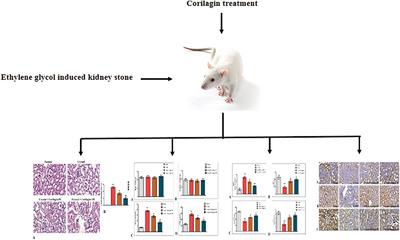当前位置:
X-MOL 学术
›
Biotechnol. Appl. Bioc.
›
论文详情
Our official English website, www.x-mol.net, welcomes your feedback! (Note: you will need to create a separate account there.)
The protective role of corilagin on renal calcium oxalate crystal-induced oxidative stress, inflammatory response, and apoptosis via PPAR-γ and PI3K/Akt pathway in rats
Biotechnology and Applied Biochemistry ( IF 2.8 ) Pub Date : 2020-10-20 , DOI: 10.1002/bab.2054 Haibo Yuan 1 , Jinghong Zhang 1 , Xiaosong Yin 1 , Tongwei Liu 1 , Xiao Yue 1 , Chuangui Li 1 , Yuanyuan Wang 1 , Ding Li 1 , Qiang Wang 1
Biotechnology and Applied Biochemistry ( IF 2.8 ) Pub Date : 2020-10-20 , DOI: 10.1002/bab.2054 Haibo Yuan 1 , Jinghong Zhang 1 , Xiaosong Yin 1 , Tongwei Liu 1 , Xiao Yue 1 , Chuangui Li 1 , Yuanyuan Wang 1 , Ding Li 1 , Qiang Wang 1
Affiliation

|
Kidney stones, also known as calcium oxalate (CaOx) nephrolithiasis, are often asymptomatic, leading to kidney injury and renal failure complications. Corilagin is a gallotannin found in various plants and is known to elicit various biological activities. The present study aimed to elucidate the renoprotective effect of corilagin against the rats’ renal stones deposition. The rats were induced for nephrolithiasis (CaOx deposition) using 0.75% ethylene glycol in their drinking water. Then, they were treated with corilagin at 50 and 100 mg/kg/day for 4 weeks. At the end of the experimental period, the rats were killed; blood and renal tissues were collected for various histological, biochemical, and gene expression analyses. The results demonstrated that the rats had renal calculi displaying a significant increase in serum creatinine (59.39 μmol/L) and blood urea nitrogen (19.03 mmol/L) levels compared with controls. Moreover, the malondialdehyde (13.29 nmol/mg) level was found to increase with a profound reduction in antioxidants’ activities with upregulated inflammatory cytokines. In contrast, the RT-PCR and immunohistochemistry analysis demonstrated a substantial reduction in cell survival markers PPAR-γ and PI3K/Akt with an apparent increase in apoptosis markers genes expressions in rats suffering from renal stones. Thus, the present study results suggest that corilagin could suppress renal CaOx crystal-induced oxidative stress, inflammatory response, and apoptosis via PPAR-γ and PI3K/Akt-mediated pathway.
中文翻译:

Corilagin通过PPAR-γ和PI3K/Akt通路对大鼠肾草酸钙晶体诱导的氧化应激、炎症反应和细胞凋亡的保护作用
肾结石,也称为草酸钙 (CaOx) 肾结石,通常无症状,可导致肾损伤和肾衰竭并发症。Corilagin 是一种在各种植物中发现的没食子单宁,已知可引发各种生物活性。本研究旨在阐明corilagin对大鼠肾结石沉积的肾脏保护作用。在大鼠的饮用水中使用 0.75% 乙二醇诱导大鼠肾结石(CaOx 沉积)。然后,他们用 50 和 100 mg/kg/天的 corilagin 治疗 4 周。实验期结束,处死大鼠;收集血液和肾组织用于各种组织学、生化和基因表达分析。结果表明,大鼠有肾结石,血清肌酐显着升高(59. 39 μmol/L)和血尿素氮(19.03 mmol/L)水平与对照组相比。此外,发现丙二醛(13.29 nmol/mg)水平随着抗氧化剂活性的显着降低而增加,炎症细胞因子上调。相比之下,RT-PCR 和免疫组织化学分析表明,肾结石大鼠的细胞存活标志物 PPAR-γ 和 PI3K/Akt 显着降低,凋亡标志物基因表达明显增加。因此,本研究结果表明,corilagin 可以通过 PPAR-γ 和 PI3K/Akt 介导的途径抑制肾 CaOx 晶体诱导的氧化应激、炎症反应和细胞凋亡。发现 29 nmol/mg) 水平随着抗氧化剂活性的显着降低而增加,炎症细胞因子上调。相比之下,RT-PCR 和免疫组织化学分析表明,肾结石大鼠的细胞存活标志物 PPAR-γ 和 PI3K/Akt 显着降低,凋亡标志物基因表达明显增加。因此,本研究结果表明,corilagin 可以通过 PPAR-γ 和 PI3K/Akt 介导的途径抑制肾 CaOx 晶体诱导的氧化应激、炎症反应和细胞凋亡。发现 29 nmol/mg) 水平随着抗氧化剂活性的显着降低而增加,炎症细胞因子上调。相比之下,RT-PCR 和免疫组织化学分析表明,肾结石大鼠的细胞存活标志物 PPAR-γ 和 PI3K/Akt 显着降低,凋亡标志物基因表达明显增加。因此,本研究结果表明,corilagin 可以通过 PPAR-γ 和 PI3K/Akt 介导的途径抑制肾 CaOx 晶体诱导的氧化应激、炎症反应和细胞凋亡。RT-PCR 和免疫组织化学分析表明,肾结石大鼠的细胞存活标志物 PPAR-γ 和 PI3K/Akt 显着降低,凋亡标志物基因表达明显增加。因此,本研究结果表明,corilagin 可以通过 PPAR-γ 和 PI3K/Akt 介导的途径抑制肾 CaOx 晶体诱导的氧化应激、炎症反应和细胞凋亡。RT-PCR 和免疫组织化学分析表明,肾结石大鼠的细胞存活标志物 PPAR-γ 和 PI3K/Akt 显着降低,凋亡标志物基因表达明显增加。因此,本研究结果表明,corilagin 可以通过 PPAR-γ 和 PI3K/Akt 介导的途径抑制肾 CaOx 晶体诱导的氧化应激、炎症反应和细胞凋亡。
更新日期:2020-10-20
中文翻译:

Corilagin通过PPAR-γ和PI3K/Akt通路对大鼠肾草酸钙晶体诱导的氧化应激、炎症反应和细胞凋亡的保护作用
肾结石,也称为草酸钙 (CaOx) 肾结石,通常无症状,可导致肾损伤和肾衰竭并发症。Corilagin 是一种在各种植物中发现的没食子单宁,已知可引发各种生物活性。本研究旨在阐明corilagin对大鼠肾结石沉积的肾脏保护作用。在大鼠的饮用水中使用 0.75% 乙二醇诱导大鼠肾结石(CaOx 沉积)。然后,他们用 50 和 100 mg/kg/天的 corilagin 治疗 4 周。实验期结束,处死大鼠;收集血液和肾组织用于各种组织学、生化和基因表达分析。结果表明,大鼠有肾结石,血清肌酐显着升高(59. 39 μmol/L)和血尿素氮(19.03 mmol/L)水平与对照组相比。此外,发现丙二醛(13.29 nmol/mg)水平随着抗氧化剂活性的显着降低而增加,炎症细胞因子上调。相比之下,RT-PCR 和免疫组织化学分析表明,肾结石大鼠的细胞存活标志物 PPAR-γ 和 PI3K/Akt 显着降低,凋亡标志物基因表达明显增加。因此,本研究结果表明,corilagin 可以通过 PPAR-γ 和 PI3K/Akt 介导的途径抑制肾 CaOx 晶体诱导的氧化应激、炎症反应和细胞凋亡。发现 29 nmol/mg) 水平随着抗氧化剂活性的显着降低而增加,炎症细胞因子上调。相比之下,RT-PCR 和免疫组织化学分析表明,肾结石大鼠的细胞存活标志物 PPAR-γ 和 PI3K/Akt 显着降低,凋亡标志物基因表达明显增加。因此,本研究结果表明,corilagin 可以通过 PPAR-γ 和 PI3K/Akt 介导的途径抑制肾 CaOx 晶体诱导的氧化应激、炎症反应和细胞凋亡。发现 29 nmol/mg) 水平随着抗氧化剂活性的显着降低而增加,炎症细胞因子上调。相比之下,RT-PCR 和免疫组织化学分析表明,肾结石大鼠的细胞存活标志物 PPAR-γ 和 PI3K/Akt 显着降低,凋亡标志物基因表达明显增加。因此,本研究结果表明,corilagin 可以通过 PPAR-γ 和 PI3K/Akt 介导的途径抑制肾 CaOx 晶体诱导的氧化应激、炎症反应和细胞凋亡。RT-PCR 和免疫组织化学分析表明,肾结石大鼠的细胞存活标志物 PPAR-γ 和 PI3K/Akt 显着降低,凋亡标志物基因表达明显增加。因此,本研究结果表明,corilagin 可以通过 PPAR-γ 和 PI3K/Akt 介导的途径抑制肾 CaOx 晶体诱导的氧化应激、炎症反应和细胞凋亡。RT-PCR 和免疫组织化学分析表明,肾结石大鼠的细胞存活标志物 PPAR-γ 和 PI3K/Akt 显着降低,凋亡标志物基因表达明显增加。因此,本研究结果表明,corilagin 可以通过 PPAR-γ 和 PI3K/Akt 介导的途径抑制肾 CaOx 晶体诱导的氧化应激、炎症反应和细胞凋亡。


























 京公网安备 11010802027423号
京公网安备 11010802027423号